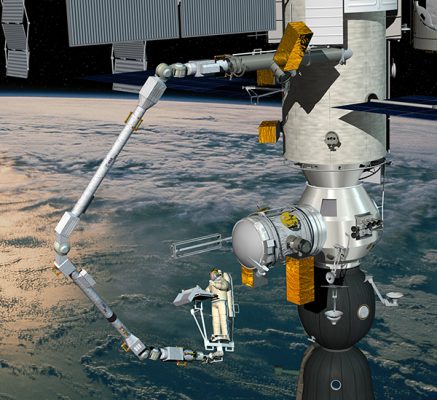On July 5, a press event took place at ESA ESTEC in Noordwijk in anticipation of the launch of the ESA’s European Robotic Arm with the Proton rocket to ISS (International Space Station). The launch will take place in Baikonur (Kazachstan) on July 15.
There were several speakers to talk about the technology used and the added value for astronauts. Spare parts of ERA were shown and demonstrated. The following speakers were present:
Mona Keijzer, Dutch Secretary of State responsible for space exploration; Franco Ongaro, ESA Director Technology, Engineering and Quality, and Head ESA ESTEC; Harm van de Wetering, Director Netherlands Space Office; Philippe Schoonejans, ESA ERA Project Manager; Systze Kampen, Head Technology at Airbus Defence and Space in The Netherlands and André Kuipers, ESA Astronaut.
Franco Ongaro, gave a warm welcome to the audience and mentioned that the European Robotic Arm is ready now for launching to the International Space Centre (ISS).
In her presentation, Mona Keijzer mentioned that she was very proud of this project, this was a big achievement in mankind and that we cannot live without satellites anymore, (like for instance. weather forecast, GPS, agriculture, maritime purposes, communication, etc). She wished the project a lot of success.
André Kuipers mentioned that the ERA can among others, be used to move big things around, to put equipment on the outside, to help with inspection and for the astronauts to use for work outside ISS.
European Robotic Arm
The ERA is much like a human arm. It has an elbow, shoulders and even wrists. The European Robotic Arm (ERA) is the first robot able to ‘walk’ around the Russian segment of the International Space Station.
Light yet powerful, the orbital arm has the ability to anchor itself to the Station and move back and forward by itself, hand-over-hand between fixed base-points. This space robot looks like a pair of compasses and has a length of over 11 m. When stretched, it could pass a football from a penalty spot to the goalkeeper. The robot will serve as main manipulator on the Russian part of the Space Station. Its seven joints can handle multi-tons of payloads with a large range of motion for assembly tasks.
The arm and its two control stations – one for inside and another for outside the orbital outpost – will be launched into space together with the Multipurpose Laboratory Module, called ‘Nauka’, from the Baikonur Cosmodrome, in Kazakhstan, on a Russian Proton rocket. The launch is set for July 15, 2021, after two decades of technical and programmatic challenges.
The robotic arm brings new ways of operating automated machines to the orbital complex. ERA has the ability to perform many tasks automatically or semi-automatically, can be directed either from inside or outside the Station, and it can be controlled in real time or preprogrammed.
Once it starts working from its home base at the Russian Multipurpose Laboratory Module the robot arm can help install, deploy and replace elements in outer space. ERA’s first tasks in orbit, after deployment and checkouts, are to set up the airlock and install a radiator for the latest module of the Space Station.
Astronauts will use the robotic arm to save time and effort in Space Station maintenance. It will act as a tool to transfer small payloads directly from inside to outside the International Space Station without the need for spacewalks, but will also help spacewalkers by transporting them around like a cherry-picker crane. Its four infrared cameras will support inspections and operations outside the Space Station.
Why ERA?
The International Space Station already features two robotic arms: Canadarm2 and the Japanese Experiment Module Remote Manipulator System. Both play a crucial role in berthing visiting vehicles and grappling external payloads on the US and Japanese modules. However, the Canadian and Japanese arms cannot reach the Russian segment of the International Space Station. The different types of base points and payload mounting units do not allow to operate them in other parts of the Station.
ERA comes to the stage to service the Russian segment. Even though the Multipurpose Laboratory Module will be its home base, ERA’s design and flexibility provide the freedom to move hand-over-hand around the Russian parts of the Station. It will supplement the two ‘Strela’ cargo cranes. ERA is 100% European-made, and largely built in the Netherlands. A consortium of European companies led by Airbus Defense and Space Netherlands designed and assembled for the European Space Agency.
Written by Nanda Jagusiak-Monteiro
